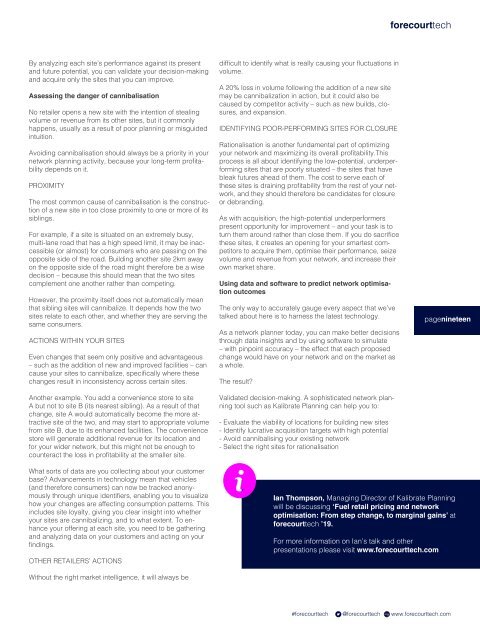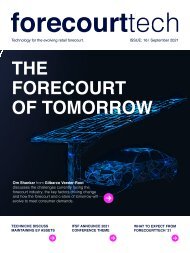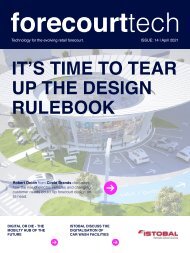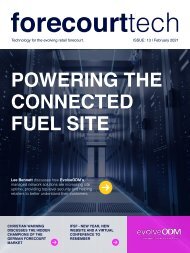forecourttech September 19
A monthly technology magazine for the evolving retail forecourt.
A monthly technology magazine for the evolving retail forecourt.
Create successful ePaper yourself
Turn your PDF publications into a flip-book with our unique Google optimized e-Paper software.
<strong>forecourttech</strong><br />
By analyzing each site’s performance against its present<br />
and future potential, you can validate your decision-making<br />
and acquire only the sites that you can improve.<br />
Assessing the danger of cannibalisation<br />
No retailer opens a new site with the intention of stealing<br />
volume or revenue from its other sites, but it commonly<br />
happens, usually as a result of poor planning or misguided<br />
intuition.<br />
Avoiding cannibalisation should always be a priority in your<br />
network planning activity, because your long-term profitability<br />
depends on it.<br />
PROXIMITY<br />
The most common cause of cannibalisation is the construction<br />
of a new site in too close proximity to one or more of its<br />
siblings.<br />
For example, if a site is situated on an extremely busy,<br />
multi-lane road that has a high speed limit, it may be inaccessible<br />
(or almost) for consumers who are passing on the<br />
opposite side of the road. Building another site 2km away<br />
on the opposite side of the road might therefore be a wise<br />
decision – because this should mean that the two sites<br />
complement one another rather than competing.<br />
However, the proximity itself does not automatically mean<br />
that sibling sites will cannibalize. It depends how the two<br />
sites relate to each other, and whether they are serving the<br />
same consumers.<br />
ACTIONS WITHIN YOUR SITES<br />
Even changes that seem only positive and advantageous<br />
– such as the addition of new and improved facilities – can<br />
cause your sites to cannibalize, specifically where these<br />
changes result in inconsistency across certain sites.<br />
Another example. You add a convenience store to site<br />
A but not to site B (its nearest sibling). As a result of that<br />
change, site A would automatically become the more attractive<br />
site of the two, and may start to appropriate volume<br />
from site B, due to its enhanced facilities. The convenience<br />
store will generate additional revenue for its location and<br />
for your wider network, but this might not be enough to<br />
counteract the loss in profitability at the smaller site.<br />
difficult to identify what is really causing your fluctuations in<br />
volume.<br />
A 20% loss in volume following the addition of a new site<br />
may be cannibalization in action, but it could also be<br />
caused by competitor activity – such as new builds, closures,<br />
and expansion.<br />
IDENTIFYING POOR-PERFORMING SITES FOR CLOSURE<br />
Rationalisation is another fundamental part of optimizing<br />
your network and maximizing its overall profitability.This<br />
process is all about identifying the low-potential, underperforming<br />
sites that are poorly situated – the sites that have<br />
bleak futures ahead of them. The cost to serve each of<br />
these sites is draining profitability from the rest of your network,<br />
and they should therefore be candidates for closure<br />
or debranding.<br />
As with acquisition, the high-potential underperformers<br />
present opportunity for improvement – and your task is to<br />
turn them around rather than close them. If you do sacrifice<br />
these sites, it creates an opening for your smartest competitors<br />
to acquire them, optimise their performance, seize<br />
volume and revenue from your network, and increase their<br />
own market share.<br />
Using data and software to predict network optimisation<br />
outcomes<br />
The only way to accurately gauge every aspect that we’ve<br />
talked about here is to harness the latest technology.<br />
As a network planner today, you can make better decisions<br />
through data insights and by using software to simulate<br />
– with pinpoint accuracy – the effect that each proposed<br />
change would have on your network and on the market as<br />
a whole.<br />
The result?<br />
Validated decision-making. A sophisticated network planning<br />
tool such as Kalibrate Planning can help you to:<br />
- Evaluate the viability of locations for building new sites<br />
- Identify lucrative acquisition targets with high potential<br />
- Avoid cannibalising your existing network<br />
- Select the right sites for rationalisation<br />
pagenineteen<br />
What sorts of data are you collecting about your customer<br />
base? Advancements in technology mean that vehicles<br />
(and therefore consumers) can now be tracked anonymously<br />
through unique identifiers, enabling you to visualize<br />
how your changes are affecting consumption patterns. This<br />
includes site loyalty, giving you clear insight into whether<br />
your sites are cannibalizing, and to what extent. To enhance<br />
your offering at each site, you need to be gathering<br />
and analyzing data on your customers and acting on your<br />
findings.<br />
OTHER RETAILERS’ ACTIONS<br />
Ian Thompson, Managing Director of Kalibrate Planning<br />
will be discussing ‘Fuel retail pricing and network<br />
optimisation: From step change, to marginal gains’ at<br />
<strong>forecourttech</strong> ’<strong>19</strong>.<br />
For more information on Ian’s talk and other<br />
presentations please visit www.<strong>forecourttech</strong>.com<br />
Without the right market intelligence, it will always be<br />
#<strong>forecourttech</strong> @<strong>forecourttech</strong> www.<strong>forecourttech</strong>.com


















